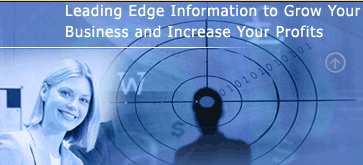|
Here’s
a scary thought: If you don’t communicate with potential
customers at least thirty times, you’re losing money.
This fascinating view was put to me recently in a conversation
I had with Jay Conrad Levinson – the father of ‘Guerrilla
Marketing’
Jay’s view, which makes a great deal of sense, goes as
follows:
There is a tradition in marketing that says that you need an
average of at least seven contacts with a potential customer
before you get a sale.
Now this will vary from business to business, but for a
typical business selling a mid price product or service, it
will often take an average of seven contacts before the
customer buys.
Perhaps the potential customer calls or emails you. That’s
the first contact. Your reply. That’s the second contact.
You follow up 10 days later with a phone call – contact
three. They have some more questions so you send more
information in the post – contact four. You email and call
again – contacts five and six. Then they call you and
they’re ready to buy – contact number seven.
Having seen how numerous businesses function, I can tell you
that most give up at the second contact. It’s absolutely
vital that you follow and keep following up.
This seven step sales process used be called the ‘Call,
Letter’ process. The sequence would often go:
Call, Letter, Call, Letter, Call, Letter, Call SALE
Of course now we can add email, so the sequence might go:
Call, Email, Letter, Call, Email, Letter, Call, SALE
But Jay Conrad Levinson – Mr Guerrilla Marketing –
believes that we’re being far too optimistic with our
seven-step approach.
His point is that we are now being bombarded with so much
advertising and marketing that we ignore four out of five of
the communications we see. We ignore most of our direct mail,
much of our email and certainly most of the advertising that
we see.
So if four out of five messages don’t really get through
effectively, we need to multiply our seven steps by five to
ensure that we are hitting the target. This turns our seven
step approach to a thirty five step approach!
Now, this may be a slight exaggeration, particularly if the
telephone is an important part of our communication mix. But
whether it’s seven contacts or thirty five, or somewhere in
between the point remains the same – YOU MUST FOLLOW UP MORE
WITH YOUR CUSTOMERS AND ENQUIRIES.
Step into their Shoes
If you step into the shoes of your customers you
will understand that buying is often a process, a journey,
rather that an instant decision.
Think of your own buying strategies. When you buy a car, you
probably don’t wake up one day, decide to buy a car, go to
the first salesroom you see and buy a car immediately. You may
be in the small percentage of the population that buys in this
way – but it’s unlikely.
Your ‘car buying sales process’ probably goes more like
this:
1 Decide it’s time for a new car.
2 Read some magazines, surf the web and start noticing the car
advertising
3 Call or email for some brochures or visit a showroom
4 Think about how much you can afford
5 Read the brochures
6 Visit showroom(s)
7 Possibly compare Prices
8 Buy Car!
Now imagine that you are a car retailer. How on earth do you
excel when having to deal with this type of customer who is
searching around and who will not make a quick decision.
You excel by staying in touch and following up.
The key is step three above, when the buyer puts out feelers
and makes initial contact with retailers either on the phone,
or through email or in person.
In step three, the buyer gave you the seller PERMISSION to
sell to them and communicate with them. The average retailer
(whether its cars or anything else) will send out the brochure
and leave it at that.
The retailer who excels will realise that this is just step
one in the process. If they send out the brochure, but also
follow it up with low pressure but regular communications by
telephone, email or mail – continually checking that the
potential customers has all the information that they need and
that their questions are being answered they are not
GUARANTEED the sale but they are GUARANTEED to be two or three
times more likely to win the sale, than someone who just send
out a brochure and does not consistently follow up.
I know what you’re thinking
At this point you may well be thinking “Isn’t
this all too much like hard sell?”
The answer is NO!
Here’s why.
Have you noticed that great sales people don’t really sell.
They’re just really helpful. That’s because instead of
focusing on selling – their sole focus is meeting our needs,
helping us out.
So I’m not suggesting that the ongoing communications
highlighted above is hard sell at all. Instead it’s part of
a partnership with the potential customer where you are
guiding them through the buying process, answering their
questions and meeting their needs. Much of this can be
accomplished by asking questions. By finding out precisely the
type of car our customer needs, whether they are interested in
speed, safety, price, prestige, space etc – and then by
offering them solutions to their needs, we would rise above
the competition and become the obvious choice when the moment
comes to buy the car.
I have used the car buying example here because it’s
something we can all relate to. But the principles apply to
your business and your customers too.
It’s not always about You
We have to remember that most people have a great
deal of ‘stuff’ going on in their lives. Most people are
struggling financially. Many have relationship difficulties
and the vast mass of the population have little idea of what
they really want in life and where they are going. So if
buying your product or service is not their number one
priority at this precise moment in time – it may have
absolutely nothing to do with you and a great deal to do with
the fact that they have other priorities to deal with.
That’s why communicating to them over time works so
wonderfully. Peoples’ circumstances change. The person who
won’t even take your call today may be in a totally
difference emotional place next month and far more open to
your contact – so keep in touch and keep following up.
Follow up with Customers
It’s not just following up with potential new
customers that is vital for your business success.
Many businesses lose out on considerable profits by not
following up with their existing customers.
As you know, if someone has done business with you once, they
are far more likely to do business with you again than a
‘cold’ prospect – someone who you have no relationship
with.
So one of your top priorities should be to have a follow up
system for your existing customers, offering them new and
additional products and services – as well as ensuring that
they are delighted with what you are currently offering them.
Again, the best approach is normally a combination of email,
mailings and direct communication by telephone or in person.
The precise mix depends on what you are offering and your
prices so TEST various combinations.
A Vital Distinction
The vital distinction underpinning what we are
covering here is that when you call, email, mail or contact a
customer or potential customer in any form – the fact that
they don’t buy from you today does not mean that they are
not going to buy from you in the future.
There will always be a handful of people who do not want to
hear from you again. They will express this desire to you very
clearly!
For everyone else – keep in touch, again and again and again
and again. Your patience and persistence will pay off to a
level that your competitors cannot begin to imagine.
|




